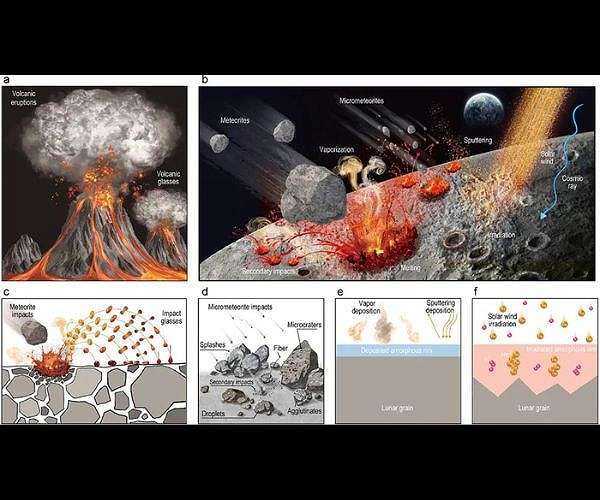9.05.2023

Schematic diagram of the different origins of various glassy substances on the lunar surface.
Glass is typically associated with floor-to-ceiling windows, colorful crafts, and electronic screens. However, it is not only a crucial man-made material but also a naturally occurring substance found in nature. The moon's surface, despite being desolate and barren, contains abundant glassy substances formed by volcanic eruptions, geological movements, and meteorite impacts. Lunar glass can remain stable for hundreds of millions of years, preserving ancient lunar materials and environmental information, similar to how amber does on Earth.
China's Chang'e-5 mission marked the country's first extraterrestrial sampling, successfully collecting and returning the youngest and highest latitude lunar soil samples to date. These samples provide insight into the moon's origin, evolution, surface, and space environment, while promoting in-situ utilization of lunar resources. This mission has also supplied valuable samples for studying extraterrestrial glass substances.
A team led by Academician Wang Weihua from the Institute of Physics of the Chinese Academy of Sciences recently conducted systematic material science research on the Chang'e-5 lunar soil samples, focusing on glass. Researchers Bai Haiyang, Shen Laiquan, Zhao Rui, Chang Chao, and Xiao Dongdong analyzed the morphology, composition, microstructure, and formation mechanism of glass/amorphous materials in lunar soil.
They discovered various types and origins of lunar glass materials, constructing a classification catalog of lunar soil glass/amorphous phases. Their research on lunar soil glass has laid a foundation for understanding the moon's material composition and space-time evolution and provided a scientific basis for in-situ processing and manufacturing of glass materials and devices based on lunar soil resources.
The research team discovered that various forms of glass on the moon's surface originate from multiple transformation paths involving solids, liquids, and gases. Frequent meteorite and micrometeorite impacts on the lunar surface cause minerals to melt and rapidly cool, producing a range of glass substances. These include rotating-shaped glass beads (spherical, ellipsoidal, dumbbell-shaped), cement with pore structures, and fluid forms of sputtering.
These impact-originated glass materials record multi-scale impact events on the lunar surface, ranging from kilometers to nanometers. The morphology of the solidified glass depends on the viscosity of the glass-forming liquid, which is dominated by the impact temperature and can help determine the intensity of meteorite impacts. Additionally, a nanoscale amorphous layer exists on the surface of lunar soil particles. Detailed structural and compositional analyses reveal two distinct origins for these nanoamorphous layers: radiation damage induced by solar wind particle injection, which converts a crystalline solid into a glassy state; and thermal evaporation deposition, where vapor deposition forms an amorphous film on the surface of mineral particles.
The widespread vapor-deposited amorphous layer identified in this study resolves the current debate about the presence of a sedimentary layer on the Chang'e-5 lunar soil grains' surface. Glass materials originating from melt cooling, vapor deposition, and ion irradiation reveal the interaction between the lunar surface and space environment, significantly contributing to understanding the formation and evolution of lunar regolith.
It's important to note that the glass material in the Chang'e-5 lunar soil exhibits characteristics significantly different from those of the Apollo lunar soil. Firstly, the research team reported naturally occurring glass fibers in the Chang'e-5 lunar soil for the first time. These ultra-high aspect ratio glass fibers are formed by thermoforming a viscous liquid during impact, similar to hot drawing amorphous filaments in a laboratory. Compared to low aspect ratio glass beads, liquid-forming glass fibers have higher viscosity, meaning the corresponding impact temperature and rate are lower. This reflects milder micro-impact events on the lunar surface.
These natural glass fibers demonstrate that lunar soil possesses a strong glass-forming ability and excellent processing and molding characteristics. This finding confirms the feasibility of using lunar soil to process and produce glass building materials on the moon's surface, providing crucial support for constructing future lunar bases.
Moreover, the research team discovered that the nano-deposited amorphous layer on the Chang'e-5 lunar soil surface is much thinner than that of the Apollo lunar soil samples. It contains almost no refractory elements and nano-metal iron particles, being composed only of silicon (Si) and oxygen (O). This indicates that the impact intensity of micrometeorites that vaporized lunar surface material was lower, resulting in less hot steam produced per impact event and temperatures low enough to prevent gasification of other refractory elements.
These characteristics reveal a generally more benign impact environment on the lunar surface within the Chang'e-5 landing zone. This finding not only successfully explains the contradiction between the high degree of weathering and low glass content in the Chang'e-5 lunar soil, but also holds guiding significance for research on scientific issues such as space weathering, spectral characteristics, and water content on the lunar surface in the landing area.
Editor's Note: This report is a machine translation of a CNSA report that has been further processed by ChatGPT4. See the original CNSA report that has additional imagery.
Quelle: SD

